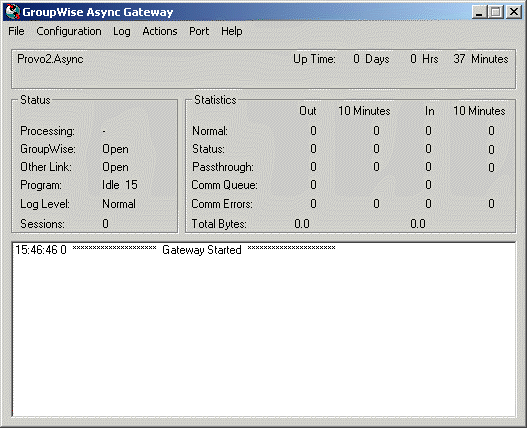Starting the Async Gateway
Select the platform where you installed the Async Gateway.
NetWare: Starting the Async Gateway
To start the Async Gateway NLMTM at the NetWare® server console, enter:
load install_path\ngwasync @install_path\gwasync.cfg
where install_path is the path where the gateway files are installed.
For example:
load ngwasync @gwasync.cfg
The gwasync.cfg file includes the /home startup switch, which is required to start the gateway. Other startup switches are optional. The gateway server console should appear and display normal startup status messages. For more information, see Using the Async Gateway Server Console.
When you start the gateway as described above, it is configured according to the gateway properties specified in ConsoleOne®. You can go back to ConsoleOne and modify gateway properties as needed.
Another way to start the NetWare Async Gateway is to run the async.ncf file. If you want the Async Gateway to start whenever the server restarts, add an async.ncf line to your server's autoexec.ncf file.
Running the NetWare Async Gateway from Another File Server
If the file server where GroupWise is running has limited disk space, memory, or power, or if it is routinely busy with other processes, you might want to run the gateway and port drivers from a different file server. To do this, install the NLM files at another server and use a load syntax that points the process to the server. This requires that you use the /home, /user, and /password startup switches when you load the Async Gateway NLM.
Syntax:
load ngwasync /home- path_to_gateway /user- NetWare_user_ID
/password-NetWare password
Example:
load ngwasync /home-Server\sys1:headq\wpgate\async /user-Ernie
/password-crevasse
If you use your own user ID and password in the gwasync.cfg file, they are secure if you have copied the file to a sys:\system directory where you are the only user with rights.
Setting Up a Connection User
If you want more complete security for your Async Gateway, you can set up a user account on the GroupWise file server specifically for your Async Gateway. If you create such an account, it should have the following network rights:
| Directory | Rights |
|---|---|
GroupWise Domain Directory |
Read, File Scan |
GroupWise Home Directory |
Read, Write, Create, Erase, Modify |
If the gateway resides on a server in another Novell eDirectoryTM tree, you must set up a bindery context so the gateway can attach to the GroupWise server.
Gwasync.cfg File
Gwasync.cfg is an ASCII text file that stores the startup switches (see Using Async Gateway Startup Switches, for further information) used by the Async Gateway. Startup switches configure the gateway to work in your specific network environment. You can edit gwasync.cfg and the startup switches in a text editor.
When you load the Async Gateway, include the full path to the startup file. For example:
load async @sys:\apps\nlm\gwasync.cfg
If the full path is not provided, the gateway searches for it first in the subdirectory where ngwasync.nlm resides and then in the sys:\system directory.
If you want to automatically load the gateway each time the server is brought up, you can modify the server's autoexec.ncf file to include the load command.
You can specify a different startup filename in the load command by using the @ switch on the command line, as in the following example:
load async @sys:\apps\nlm\gwaync.ncf
If no startup file is specified on the command line, the gateway searches for the default startup file (gwasync.cfg) using the same search parameters.
Windows: Starting the Async Gateway
Select the installation method you chose for the Async Gateway.
Starting the Gateway as a Windows Application
-
At the Windows server, click Start > Programs.
-
Click GroupWise Async Gateway > Async Gateway > Start.

For more information, see Using the Async Gateway Server Console.
Starting the Gateway as a Windows Service
If the domain that the Async Gateway belongs to is located on a NetWare server, create an eDirectory user account with a username and password that are the same as a Windows administrator user. This eDirectory account should also have all the security rights assigned for an administrator. If the Async Gateway's domain is on a Windows server, you do not need to create this account.
-
At the Windows server, click Start > Settings > Control Panel.
-
Double-click Services.
or
Click Administrative Tools, then double-click Services.
-
Right-click the Async Gateway service, then click Properties.
-
In the Startup Type field, select Automatic.
-
Click Log On, then select This Account.
-
Specify the username and the password.
-
Click OK to save your changes and return to the list of services.
-
Right-click the Async Gateway, then click Start.